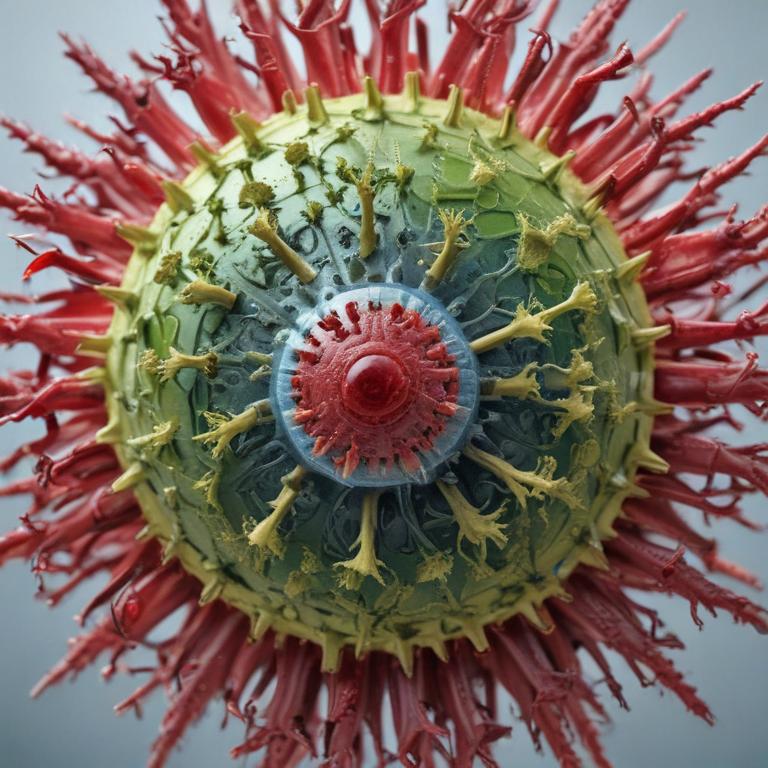发音 (Pronunciation):
IPA: /ˈvaɪrəs/
中文近似: 外若斯
中文意思与词性 (Meanings & Part of Speech):
- 病毒(可指引起疾病的微小生物体) (n.)
- 电脑病毒(指能破坏计算机系统的恶意程序) ((待补充))
例句 (Examples):
1. The flu is caused by a virus.
(流感是由病毒引起的。)
2. The computer was infected with a virus.
(这台电脑感染了病毒。)
用法提示 (Usage Tip):
virus 通常指医学上的病毒,也可用于指电脑病毒。不要将其与 bacteria(细菌)混淆,细菌和病毒是不同的微生物。
更多关于 "virus" (More about "virus")
单词来源 (Etymology)
“virus”一词源自拉丁语,原意为“毒液、毒素”,后来用于指引发疾病的微生物体。
词根词缀解析 (Root & Affix Analysis)
virus 是基础词汇,来源于拉丁语,属于基础医学与科技常用词,无明显词根前后缀。
“virus”的字母与词根个性化解读
字母象形/引申义 (个性化参考)
- 字母 'v' 的象形或引申含义可能包括: 山谷 -> 风口 -> 路 -> 往返/走 (via, vent); 牛角 -> 牛 -> 强壮征服 -> 能力价值 (val, vinc); 转和活 (vol同源); 手 (V=F); 音变: V=U=W; V=B=P=M=F。
- 字母 'i' 的象形或引申含义可能包括: 我 (an, any, one -> 人); 水滴 -> 水 (ice); 尖, 一点, 小 (inch); 元音互换: A=E=I=O=U=W=Y。
- 字母 'r' 的象形或引申含义可能包括: 直立, 向上 (字母R形); 走, 跑 (R象形人); 弯曲 (舌头卷曲); 音变: R=L=M=N。
- 字母 'u' 的象形或引申含义可能包括: 中空 -> 容器 -> 用具 -> 使用; 音变: U=V=W; U=A=E=I=O=Y。
- 字母 's' 的象形或引申含义可能包括: 水波纹/走路痕迹 (S象形); 吐气轻细咝 -> 说话 (拟声); 音变: S=C=Z=TH=X。
学习提示:以上针对单词 virus 的字母和词根解读,主要基于提供的特定象形及词根资料。这些提示旨在启发联想,而非绝对定论。更通用的记忆规则和原则请参考首页。英语词源复杂多变,实际应用中请结合更全面的词源词典和语言学知识进行深入学习。
常用词组 (Common Phrases)
- spread of the virus: 病毒传播
- virus infection: 病毒感染
其他语言 (Other Languages)
- 德语: Virus
- 法语: virus
字母整体创意联想
单词 virus 形状像一串散开的细胞,字母“v”像尖锐的病毒外壳,末尾的“s”像病毒尾巴飘动。
逐字母创意解读
中文谐音助记
“virus” 谐音“外扰死”,记住病毒是外来侵扰生物体,可能引起疾病甚至死亡。
相关电影/名言
"It's a virus. It infects the system."
(这是一种病毒。它感染了系统。)
- 《黑客帝国》(1999)
趣味知识/故事
世界上第一个被人类正式发现的病毒是1892年的烟草花叶病毒。最早对于病毒的理解,很多人误以为它是液体的毒素,直到后来显微镜技术进步,科学家才发现病毒其实体积极小,只能在活细胞中繁殖。
拓展信息
virus 在生物学上专指一类只能在活细胞内繁殖的微生物,无法独立生存。
在计算机领域,virus 指编写出来用于破坏或干扰计算机系统的恶意程序。
virus 的复数形式为 viruses,注意不可写作 “virii”。
网络参考 (More about "virus" from the Web)
Virus - Wikipedia
A virus is a submicroscopic infectious agent that replicates only inside the living cells of an organism. Learn about the different types, shapes, and transmission modes of viruses, as well as the hypotheses on their evolutionary history.
Viruses: Definition, Types, Characteristics & Facts - Cleveland Clinic
The virus uses the host cell's machinery to make more copies of itself. Pieces of the virus assemble, wrapping up the genetic material in the capsid. Viruses make many copies of themselves this way. Eventually, there are so many copies of the virus inside the cell that it bursts. Those virions can now go and infect more cells. Lysogenic cycle.
Virus | Definition, Structure, & Facts | Britannica
virus, infectious agent of small size and simple composition that can multiply only in living cells of animals, plants, or bacteria.The name is from a Latin word meaning "slimy liquid" or "poison.". The earliest indications of the biological nature of viruses came from studies in 1892 by the Russian scientist Dmitry I. Ivanovsky and in 1898 by the Dutch scientist Martinus W. Beijerinck.
更多图片 (virus More Images)

